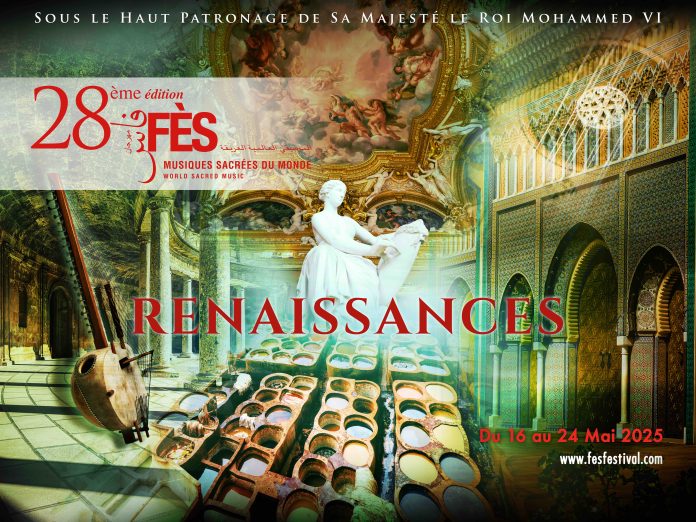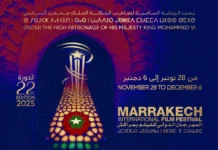At Bab Makina on Saturday night, the Fes Festival created a rare and mesmerizing moment where musical boundaries seemed to disappear. Under the direction of Antonio Greco and Mohammed Briouel, two seemingly distant traditions—the baroque liturgy of Monteverdi’s Vespers of the Blessed Virgin and the intricate melodies of the Fes Arabo-Andalusian Orchestra—came together in a seamless, unexpected fusion. The result was nothing short of transformative.
The setting itself deepened the atmosphere. Projections danced across the ochre walls of Bab Makina, blending Christian iconography with floral patterns in a visual display that felt both sacred and sensory. Images of Monteverdi and Marian churches appeared alongside rippling motifs of water and light, enhancing the spiritual dimension of the performance without overpowering it.
What unfolded musically was an extraordinary interplay. The precision and structure of baroque music met the fluid, improvisational spirit of Andalusian modes. It wasn’t just a juxtaposition—it was a true dialogue, where every note seemed to answer the one before it. The choral voices and soloists, charged with operatic power, found a resonant counterpoint in the instrumental flourishes drawn from Maghreb traditions, building an emotional bridge across the Mediterranean.
The venue was packed, yet the crowd listened in near silence, fully absorbed in the gravity of the experience. At times meditative, at others electrifying, the performance pulled the audience into a shared rhythm, one that felt both ancient and startlingly new. This bold collaboration—born from a partnership between the Fes Festival and the Monteverdi Festival in Cremona—hints at the rich creative potential that lies in crossing sacred traditions from different worlds.
Earlier in the evening, the festival showcased other dimensions of spirituality. Opening the night was Al Areej, a Sufi ensemble from Oman, performing an original piece titled The Voice of the Ancestors, composed specifically for this edition. Drawing from the rich maqâm system—Saba, Bayati, and Sika—the group unfolded a tapestry of sound deeply tied to Oman’s daily rituals and spiritual memory.
Their performance of the Maled, a Sufi practice of rhythmic gestures and symbolic movement, offered a different kind of sacred presence. Led by Omar El Breki, the musicians turned body sways into acts of devotion, creating a trance-like state that seemed to draw energy from the earth and offer it back as light.
Later, the spotlight shifted to Mayotte’s Madrassati Toiyaria, an all-women’s group that brought the Deba to the stage—a form of sung dhikr unique to the Indian Ocean. Clad in vibrant fabrics, the performers merged invocation with choreography, their fluid movements and hypnotic drumming channeling both poetry and prayer. Through their celebration of the Prophet’s birth, they embodied a deeply feminine expression of the sacred, rich with ancestral echoes.
When both ensembles came together for a final shared performance, the harmony between Omani Sufi traditions and Mahoran chants felt utterly natural. This emotional and precisely coordinated finale captured the spirit of this 28th edition’s theme: rebirths.
With over 200 artists from 15 countries, the Festival of Fes once again affirmed its unique role as a crossroads of cultures and a sanctuary for spiritual exploration. True to the city’s long history as a meeting place for knowledge and faith, the festival continues to build bridges that transcend borders, time, and language.





